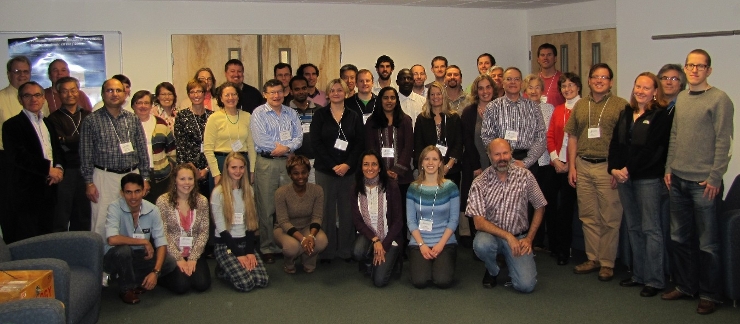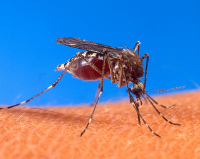| Description | Participants | Agenda | Summary | Products |
|---|
NIMBioS Investigative Workshop
Mathematical Modeling of Wildlife and Virus Zoonoses

Topic: Mathematical Modeling of Wildlife and Virus Zoonoses
Meeting dates: Nov 8-10, 2010
Organizers:
Colleen B. Jonsson, Dept. of Microbiology, Center for Predictive Medicine, Univ. of Louisville, Louisville, Kentucky
Linda J. S. Allen, Dept. of Mathematics and Statistics, Texas Tech Univ., Lubbock
Pauline van den Driessche, Dept. of Mathematics and Statistics, Univ. of Victoria
Objectives: The focus of the workshop was to define, discuss, and develop approaches to collaboratively address critical gaps that remain in mathematical modeling of the ecology and natural history of zoonotic viruses, how they are maintained in their reservoirs, the processes and mechanisms that lead to transmission, host switching, and molecular events that lead to transfer and adaptation to a new host and post-transfer adaptation. Importantly, modeling efforts are essential to the discovery of new ecological paradigms and true understanding of the nature of episodic zoonotic epidemics or outbreaks such as those caused by RNA viruses, Ebola virus, SARS CoV, Nipah virus, and Machupo virus. By bringing together experts in mathematical models in conjunction with those engaged in experimental analyses of emerging viruses, the workshop provided a venue to build collaborative efforts to integrate approaches that would result in the interpretation of ecological trends in the spread of zoonotic diseases, provide greater understanding of underlying causes of outbreaks, and provide guidelines for their control and prevention.
Evaluation report (PDF)
 Summary Report.
The investigative workshop focused on the following three topics of mathematical modeling of wildlife and viral zoonoses:
Summary Report.
The investigative workshop focused on the following three topics of mathematical modeling of wildlife and viral zoonoses:
- Topic I - modeling of interhost transmission and host switching;
- Topic II - maintaining microbes in their reservoirs;
- Topic III - molecular events that lead to transfer and adaptation.
Through lectures, poster presentations, and working group discussions by experimentalists and modelers, important factors in modeling wildlife and viral zoonoses were identified. In topic I, factors important to interhost transmission and host switching that were identified included GIS/climate data, human and reservoir behavior change and contact networks, evolutionary processes of the pathogen and the host, variability in susceptibility of host, fitness of reservoir, spatial dynamics, and the effects of intervention strategies. In topic II, specific host factors influencing the epidemiology of the virus were divided into four categories: contact/exposure, cellular entry, productive viral infection, and transmission. Issues important in modeling were identified in each of these categories. Under topic III, discussions centered on incorporating the quasispecies concept into models of intraspecies adaptation and interspecies spillover and adaptation. New collaborations were initiated, and future working groups discussed.
Products
Publications
Reynolds HT, Ingersoll TE, Barton HA. 2015. Modeling the environmental growth of Pseudogymnoascus destructans and its impact on the white-nose syndrome epidemic. Journal of Wildlife Diseases, 51(2): 318. [Online]
Blumberg S, Funk S, Pulliam JRC. 2014. Detecting differential transmissibilities that affect the size of self-limited outbreaks. PLOS Pathogens, 10(10): e1004452. [Online]
Funk S, Nishiura H, Heesterbeek H, Edmunds WJ, Checchi F. 2013. Identifying transmission cycles at the human-animal interface: The role of animal reservoirs in maintaining gambiense human African trypanosomiasis. PLoS Computational Biology, 9(1): e1002855. [Online]
Wang Y, Gautam R, Pinedo PJ, Allen LJS, Ivanek R. 2013. A stochastic model for transmission, extinction and outbreak of Escherichia coli O157:H7 in cattle as affected by ambient temperature and cleaning practices. Journal of Mathematical Biology, 69(2): 501-532. [Online]
Allen LJS, Brown VL, Jonsson CB, Klein SL, Laverty SM, Magwedere K, Owen JC, van den Driessche P. 2012. Mathematical modeling of viral zoonoses in wildlife. Natural Resource Modeling, 25(1): 5-51. [Online]
Bani-Yaghoub M, Gautam R, Shuai Z, van den Driessche P, Ivanek R. 2012. Reproduction numbers for infections with free-living pathogens growing in the environment. Journal of Biological Dynamics, 6(2): 923-940. [Online]
Hsieh YH, Ma S, Hernandez JXV, Lee VJ, Lim WY. 2011. Early Outbreak of 2009 Influenza A (H1N1) in Mexico Prior to Identification of pH1N1 Virus. PLoS ONE, 6(8): e23853. [Online]
Presentations
Allen LJS. January 2012. Mathematical modeling of viral zoonoses in wildlife. Joint Mathematics Meetings, Special Session, Boston, MA.
Bani-Yaghoub M, Gautam R, Shuai Z, van den Driessche P, Ivanek R. 7-9 October 2011. Basic and type-reproduction numbers for a compartmental model of an infectious disease with free-living pathogen. The Third International Conference on Mathematical Modeling and Analysis of Populations in Biological Systems (ICMA III), San Antonio, TX.
Lewis CL. 2011. Mathematical models with antibody and cytotoxic T lymphocyte responses due to hantavirus infections in rodents and humans. Texas Tech University.
Grants/Proposals
Bokil VA, Allen L. 2010. Stochastic patch models for the spread of disease in heterogeneous landscapes. NSF-AWM Mentoring Travel Award. $3,315. Accepted.
NIMBioS Investigative Workshops focus on broad topics or a set of related topics, summarizing/synthesizing the state of the art and identifying future directions. Workshops have up to 35 participants. Organizers and key invited researchers make up half the participants; the remaining participants are filled through open application from the scientific community. Open applicants selected to attend are notified by NIMBioS within two weeks of the application deadline. Investigative Workshops have the potential for leading to one or more future Working Groups. Individuals with a strong interest in the topic, including post-docs and graduate students, are encouraged to apply. If needed, NIMBioS can provide support (travel, meals, lodging) for Workshop attendees, whether from a non-profit or for-profit organization.
A goal of NIMBioS is to enhance the cadre of researchers capable of interdisciplinary efforts across mathematics and biology. As part of this goal, NIMBioS is committed to promoting diversity in all its activities. Diversity is considered in all its aspects, social and scientific, including gender, ethnicity, scientific field, career stage, geography and type of home institution. Questions regarding diversity issues should be directed to diversity@nimbios.org. You can read more about our Diversity Plan on our NIMBioS Policies web page. The NIMBioS building is fully handicapped accessible.
NIMBioS
1122 Volunteer Blvd., Suite 106
University of Tennessee
Knoxville,
TN 37996-3410
PH: (865) 974-9334
FAX: (865) 974-9461
Contact NIMBioS


